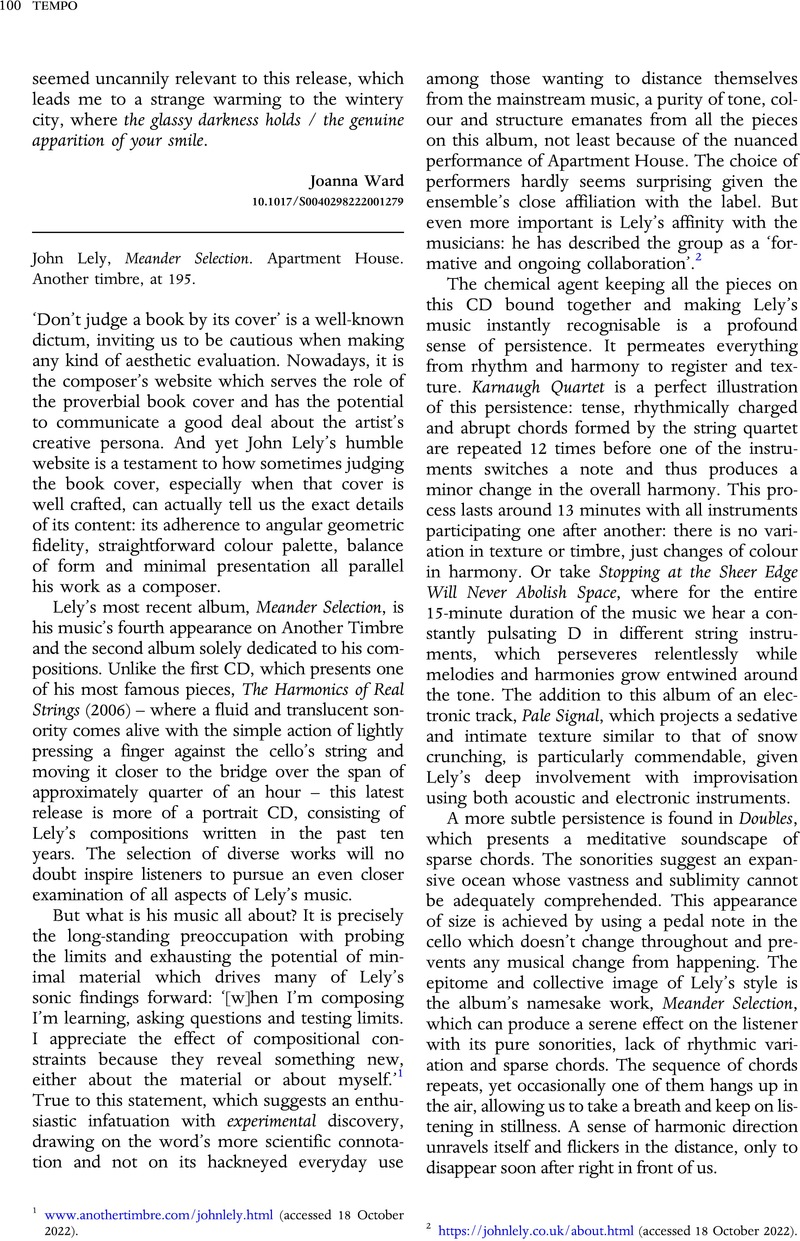‘Don't judge a book by its cover’ is a well-known dictum, inviting us to be cautious when making any kind of aesthetic evaluation. Nowadays, it is the composer's website which serves the role of the proverbial book cover and has the potential to communicate a good deal about the artist's creative persona. And yet John Lely's humble website is a testament to how sometimes judging the book cover, especially when that cover is well crafted, can actually tell us the exact details of its content: its adherence to angular geometric fidelity, straightforward colour palette, balance of form and minimal presentation all parallel his work as a composer.
Lely's most recent album, Meander Selection, is his music's fourth appearance on Another Timbre and the second album solely dedicated to his compositions. Unlike the first CD, which presents one of his most famous pieces, The Harmonics of Real Strings (2006) – where a fluid and translucent sonority comes alive with the simple action of lightly pressing a finger against the cello's string and moving it closer to the bridge over the span of approximately quarter of an hour – this latest release is more of a portrait CD, consisting of Lely's compositions written in the past ten years. The selection of diverse works will no doubt inspire listeners to pursue an even closer examination of all aspects of Lely's music.
But what is his music all about? It is precisely the long-standing preoccupation with probing the limits and exhausting the potential of minimal material which drives many of Lely's sonic findings forward: ‘[w]hen I'm composing I'm learning, asking questions and testing limits. I appreciate the effect of compositional constraints because they reveal something new, either about the material or about myself.’Footnote 1 True to this statement, which suggests an enthusiastic infatuation with experimental discovery, drawing on the word's more scientific connotation and not on its hackneyed everyday use among those wanting to distance themselves from the mainstream music, a purity of tone, colour and structure emanates from all the pieces on this album, not least because of the nuanced performance of Apartment House. The choice of performers hardly seems surprising given the ensemble's close affiliation with the label. But even more important is Lely's affinity with the musicians: he has described the group as a ‘formative and ongoing collaboration’.Footnote 2
The chemical agent keeping all the pieces on this CD bound together and making Lely's music instantly recognisable is a profound sense of persistence. It permeates everything from rhythm and harmony to register and texture. Karnaugh Quartet is a perfect illustration of this persistence: tense, rhythmically charged and abrupt chords formed by the string quartet are repeated 12 times before one of the instruments switches a note and thus produces a minor change in the overall harmony. This process lasts around 13 minutes with all instruments participating one after another: there is no variation in texture or timbre, just changes of colour in harmony. Or take Stopping at the Sheer Edge Will Never Abolish Space, where for the entire 15-minute duration of the music we hear a constantly pulsating D in different string instruments, which perseveres relentlessly while melodies and harmonies grow entwined around the tone. The addition to this album of an electronic track, Pale Signal, which projects a sedative and intimate texture similar to that of snow crunching, is particularly commendable, given Lely's deep involvement with improvisation using both acoustic and electronic instruments.
A more subtle persistence is found in Doubles, which presents a meditative soundscape of sparse chords. The sonorities suggest an expansive ocean whose vastness and sublimity cannot be adequately comprehended. This appearance of size is achieved by using a pedal note in the cello which doesn't change throughout and prevents any musical change from happening. The epitome and collective image of Lely's style is the album's namesake work, Meander Selection, which can produce a serene effect on the listener with its pure sonorities, lack of rhythmic variation and sparse chords. The sequence of chords repeats, yet occasionally one of them hangs up in the air, allowing us to take a breath and keep on listening in stillness. A sense of harmonic direction unravels itself and flickers in the distance, only to disappear soon after right in front of us.
Lely's pieces often follow and develop one musical idea, yet this meticulous concentration is never coloured in one particular way: while the previously described works produce a rather radiant quality, the atmosphere of Nocturne is gloomier and more anxious. The four notes in the piano's middle register are divided into two ascending intervals: a perfect fifth and a perfect fourth which veer off their course once in a while, exposing the dramaturgy inherent in the nature of our most fundamental musical intervals. A gradual expansion from high to low register takes place across 20 minutes in For Phillip, which also works around a set of limited monophonic pitches, oscillating between lighter and darker shades.
Despite the simple harmonies, stepwise melodies and sparse textures all being a clear point of reference to the generation of British experimental composers preceding Lely, Lely's music never sounds predictable or boring. It always seeks to challenge the listener and demands their close concentration on the unfolding process, which is of high importance to the composer. Only then does it truly reward us and unravel its more concealed beauty. This release is certainly a welcome addition to the composer's catalogue, encouraging listeners to form an all-round impression of Lely's music and to soak up his intimate soundworld from different perspectives.






